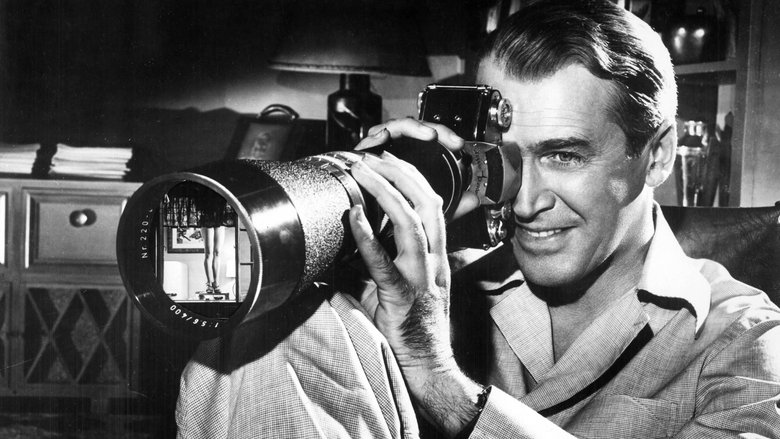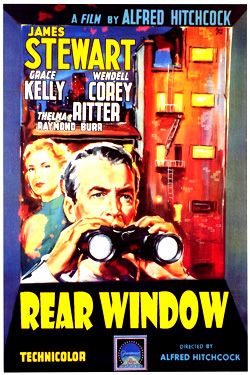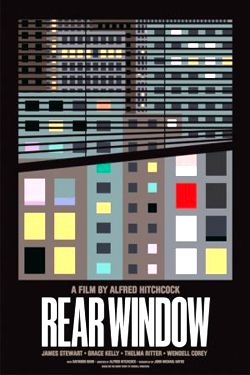← Back to Reviews

in
Plot Photojournalist L.B. Jefferies (Stewart) is used to travelling the world in search of the perfect pictures. Except that now he is stuck in his apartment as the result of a broken leg. Unable to work or do much of anything Jefferies has only the company of his girlfriend Lisa Carol Fremont (Kelly) and his home care nurse Stella (Ritter) to keep him from going stir crazy. Well their company and a little something else. With a pair of binoculars in hand Jefferies begins to form a fascination with keeping tabs on his neighbours. All seems harmless enough until he believes he has stumbled upon a murder, even if he has a hard time getting anyone to believe him. So the question is, did Thornwald (Burr) really kill his wife?
Over the last couple of years I've became a huge fan of both Alfred Hitchcock and James Stewart. And the occasions were they teamed up - Vertigo, Rope and The Man Who Knew Too Much were all big hits with me. So you'd expect that I'd have been desperate to watch this and would have done so a while back. Well I was going to but decided to save it as a treat, something to really look forward to. And a couple of nights ago I decided it was finally time.
And it's another great example of Hitchcock's wonderful craftsmanship. It's actually quite a simple film in some ways. It's a really taut, rigid A to B story which is told in quite a simple manner. Filmed in just one room the film largely consists of a basic action - Jefferies looks out the window, sees something and then reacts to it. Looks out the window, focuses on something else, reacts to it. Rinse and repeat. The only interruptions from this routine come when he is receives visits in the form of Lisa, Stella, and a cop friend of his. And yet despite this fairly static simplicity Hitchcock is able to mine great levels of suspense and intrigue. One thing that is not simple however is the terrific courtyard set that was built for the film. It is a thing of beauty, like a life-size dollhouse for Hitch to play with and manipulate. With numerous levels and individual rooms for all of the tenants it's got to be one of the most impressive sets I've ever seen built.
Alfred Hitchcock's work often had quite a pervasive and voyeuristic quality to it. This time he forces the viewer to share his leering vision as he puts us in the shoes of James Stewart's L.B. Jefferies, a photographer recovering from a broken leg. With the camera solely set in the small apartment which Jefferies inhabits (save for a couple of shots near the end) the viewer only sees and hears what Jefferies can see and hear. As a result we have quite a detached experience; safe due to the anonymity, until the moment were Thorwald looks up at Jefferies, and we are caught in the act.
As is quite common for his films Hitchcock is in no hurry to throw us right into the thick of the action. Indeed it takes over half and hour before Jefferies, and we, start to suspect anything at all may be up. In that opening half hour we are introduced to the characters and we get to know them. In fact for the opening stretch the film actually feels like it's going down the route of a relationship drama as Jefferies wrestles with whether he wants to marry Lisa or not. By taking so much time to introduce the characters and by making us care about them, we are then made to care so much more about what happens to them.
As always James Stewart proves why he was one of Hitchcock's go-to actors and why he was perhaps the best actor Hitchcock had at his disposal throughout his career. The reason for this is Stewart's terrific ability to embody the 'everyman' persona with which he is most associated. He just seems like such a normal guy that we can pretty much all identify with him. Whereas Frank Capra made good use of that quality to give us someone to root for, Hitchcock exploits it to amp up the fear we feel. If we can identify and see ourselves in Stewart, then the terror he experiences feels more real and we can just imagine it happening to us. And Stewart again delivers the goods for Hitch, giving a likeable showing full of dry humour which slowly gets more and more desperate as he deals with his confinement to his wheelchair and his inability to prove Thorwald's guilt.
As his girlfriend Lisa, Grace Kelly is just stunning to behold. Her introductory shot is a beautiful, almost ethereal entrance as she moves toward the camera before leaning in to kiss Stewart. It's perhaps the closest I've seen anyone come to matching Marilyn Monroe in terms of their sheer level of radiance on screen. And then there is the film's unsung star in the form of Thelma Ritter as Stella. She provides a large number of the laughs on show, and some of her banter with Stewart is priceless.
Another neat little trick that Hitch pulls relates to the characters who inhabit this little community that surrounds Stewart. We never 'meet' the characters beyond what we are able to see from Jefferies' window, and hear barely a word from any of them. And yet somehow Hitch is able to give each individual their own personal identity and character. Just by their actions and the running commentary provided by Jefferies, Lisa and Stella we feel as if we know them. There's the composer who has abundant talent but is struggling with the classic problem of creative block. There's the ballet dancer (aka Miss Torso) who constantly practices in her underwear while playing off numerous male suitors against each other. And then there's the lonely lady dubbed as Miss Lonelyhearts who through a series of simple shots is able to generate great sympathy as we witness her throwing dinner parties for male suitors who don't exist. All of these neighbours are used to reflect the anxieties that Jefferies has about relationships and why he is reticent to marry Lisa. Hitchcock also uses the neighbours as a rich source from which to mine his usual humour. As always with him there is a large degree of macabre humour, but there are also some lighter touches such as the antics of the newly married couple across the way.
I did find the film came up a bit short on occasion when compared against some of Hitchcock's other classics, though for the most part they seem unavoidable as they result from the manner in which the film unfolds. For a large stretch I wouldn't say the film is as thrilling, nor as full of memorable set-pieces as Strangers on a Train, Psycho, Frenzy etc. Though when we do get a memorable set-piece it's a cracker as Thorwald returns to him apartment with Lisa still inside. It's an unbelievably tense moment. Also as a result of Jefferies never really meeting or interacting with the villain until the very end I didn't find that he carried the same menace or threat as say Bruno from Strangers on a Train, Norman Bates from Psycho or Uncle Charlie in Shadow of a Doubt.
L.B. Jefferies makes for an interesting and uncommon 'hero.' Stuck in a wheelchair which he cannot leave, he has to rely on his girlfriend and home care nurse to do the dirty and dangerous work on his behalf. And then there is his overall character. After all he doesn't just happen on the murder by chance something he seems out of the corner of his eye. He witnesses it as a result of the fact that he is guilty of peeping on his neighbours and their goings on.
Conclusion The Master of Suspense delivers another classic thriller for the ages which features many vintage Hitchcock touches. Though I personally would place it around 5th I think in terms of my Hitchcock films; that however is a result of Hitchcock's level of terrific output as opposed to any great flaws with this particular film.

|

|
Year of release
1954
1954
Directed by
Alfred Hitchcock
Alfred Hitchcock
Written by
John Michael Hayes (script)
Cornell Woolrich (short story)
John Michael Hayes (script)
Cornell Woolrich (short story)
Starring
James Stewart
Grace Kelly
Thelma Ritter
Raymond Burr
James Stewart
Grace Kelly
Thelma Ritter
Raymond Burr
Rear Window
-
Plot Photojournalist L.B. Jefferies (Stewart) is used to travelling the world in search of the perfect pictures. Except that now he is stuck in his apartment as the result of a broken leg. Unable to work or do much of anything Jefferies has only the company of his girlfriend Lisa Carol Fremont (Kelly) and his home care nurse Stella (Ritter) to keep him from going stir crazy. Well their company and a little something else. With a pair of binoculars in hand Jefferies begins to form a fascination with keeping tabs on his neighbours. All seems harmless enough until he believes he has stumbled upon a murder, even if he has a hard time getting anyone to believe him. So the question is, did Thornwald (Burr) really kill his wife?
Over the last couple of years I've became a huge fan of both Alfred Hitchcock and James Stewart. And the occasions were they teamed up - Vertigo, Rope and The Man Who Knew Too Much were all big hits with me. So you'd expect that I'd have been desperate to watch this and would have done so a while back. Well I was going to but decided to save it as a treat, something to really look forward to. And a couple of nights ago I decided it was finally time.
And it's another great example of Hitchcock's wonderful craftsmanship. It's actually quite a simple film in some ways. It's a really taut, rigid A to B story which is told in quite a simple manner. Filmed in just one room the film largely consists of a basic action - Jefferies looks out the window, sees something and then reacts to it. Looks out the window, focuses on something else, reacts to it. Rinse and repeat. The only interruptions from this routine come when he is receives visits in the form of Lisa, Stella, and a cop friend of his. And yet despite this fairly static simplicity Hitchcock is able to mine great levels of suspense and intrigue. One thing that is not simple however is the terrific courtyard set that was built for the film. It is a thing of beauty, like a life-size dollhouse for Hitch to play with and manipulate. With numerous levels and individual rooms for all of the tenants it's got to be one of the most impressive sets I've ever seen built.
Film trivia Speaking of the set here are a few facts about it. At the time of construction it was the largest indoor set ever built at Paramount Studios. To accommodate the set, a higher ceiling was required, resulting in the soundstage of the studio being ripped up to reveal the basement. So the courtyard is actually down in the basement and Jefferies' apartment was actually at street level. The set featured one thousand arc lights which were used to simulate the changing light pattern of the day, from sunrise to sunset. The changeover from day to night could be made in under 45 minutes. Though the heat they generated made the residents on the top level very uncomfortable, and were actually so hot that they once set off the soundstage's sprinkler system.
As is quite common for his films Hitchcock is in no hurry to throw us right into the thick of the action. Indeed it takes over half and hour before Jefferies, and we, start to suspect anything at all may be up. In that opening half hour we are introduced to the characters and we get to know them. In fact for the opening stretch the film actually feels like it's going down the route of a relationship drama as Jefferies wrestles with whether he wants to marry Lisa or not. By taking so much time to introduce the characters and by making us care about them, we are then made to care so much more about what happens to them.
As always James Stewart proves why he was one of Hitchcock's go-to actors and why he was perhaps the best actor Hitchcock had at his disposal throughout his career. The reason for this is Stewart's terrific ability to embody the 'everyman' persona with which he is most associated. He just seems like such a normal guy that we can pretty much all identify with him. Whereas Frank Capra made good use of that quality to give us someone to root for, Hitchcock exploits it to amp up the fear we feel. If we can identify and see ourselves in Stewart, then the terror he experiences feels more real and we can just imagine it happening to us. And Stewart again delivers the goods for Hitch, giving a likeable showing full of dry humour which slowly gets more and more desperate as he deals with his confinement to his wheelchair and his inability to prove Thorwald's guilt.
As his girlfriend Lisa, Grace Kelly is just stunning to behold. Her introductory shot is a beautiful, almost ethereal entrance as she moves toward the camera before leaning in to kiss Stewart. It's perhaps the closest I've seen anyone come to matching Marilyn Monroe in terms of their sheer level of radiance on screen. And then there is the film's unsung star in the form of Thelma Ritter as Stella. She provides a large number of the laughs on show, and some of her banter with Stewart is priceless.
Film trivia The set was so impressive in construction that every apartment in Thorwald's building was equipped with electricity and running water, and was suitable for living in. Indeed Georgine Darcy (Miss Torso) actually did so in between takes. While shooting, all 'residents' stayed in their respective apartments and Hitchcock communicated with them through flesh-coloured earpieces that every actor wore.
I did find the film came up a bit short on occasion when compared against some of Hitchcock's other classics, though for the most part they seem unavoidable as they result from the manner in which the film unfolds. For a large stretch I wouldn't say the film is as thrilling, nor as full of memorable set-pieces as Strangers on a Train, Psycho, Frenzy etc. Though when we do get a memorable set-piece it's a cracker as Thorwald returns to him apartment with Lisa still inside. It's an unbelievably tense moment. Also as a result of Jefferies never really meeting or interacting with the villain until the very end I didn't find that he carried the same menace or threat as say Bruno from Strangers on a Train, Norman Bates from Psycho or Uncle Charlie in Shadow of a Doubt.
Film trivia As part of the publicity upon the film's re-release, ad campaigns carried the slogan Rear Window is such a frightening picture that one should never see it unless accompanied by an audience."
Conclusion The Master of Suspense delivers another classic thriller for the ages which features many vintage Hitchcock touches. Though I personally would place it around 5th I think in terms of my Hitchcock films; that however is a result of Hitchcock's level of terrific output as opposed to any great flaws with this particular film.
